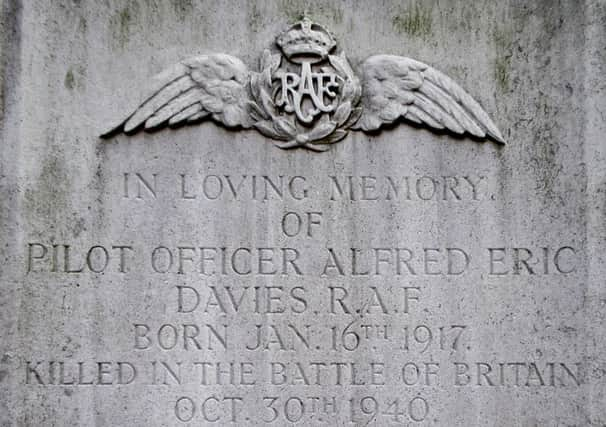Campaign to name road after pilot who fought for our land


This was 23-year-old Alfred Eric Davies who died defending Bexhill, Hastings and Crowhurst from Luftwaffe raiders overhead.
Know as Eric, he was called up in 1939 and initially served with 610 Squadron, before transferring to 222 Squadron based at RAF Hornchurch in September 1940 from where he flew almost daily combat sorties throughout summer.
Advertisement
Hide AdAdvertisement
Hide AdAndy writes: “Usually, he would have been at readiness from first light – waiting with jangled nerves for that dreaded telephone call that would send the Squadron off on yet another ‘Scramble’ to intercept the enemy.
“The pace continued to be relentless, even into the early autumn of October, and on 25 October Eric Davis shot down a Messerschmitt 109 fighter in a wild dogfight over East Sussex, and although the scale of German air activity was slowing down it still left no time to draw breath and relax, because still the German raiders came.
“Probably at the point of near physical and mental exhaustion, Eric and his comrades were on yet another patrol over Sussex on Wednesday 30 October when they were directed towards an enemy raid coming in near Dover, but over the coast at Bexhill the squadron of Spitfires ran into the enemy. It was mayhem.
“Shortly after 11.15 a formation of German fighters, flying higher than the twelve RAF aircraft, fell onto the defending fighters and in moments three of the Spitfires had been shot down.
Advertisement
Hide AdAdvertisement
Hide Ad“One, flown by Eric’s friend, Pilot Officer Edridge, crashed fatally to earth at Great Dixter, Northiam, while Pilot Officer ‘Chips’ Carpenter had his Spitfire riddled with bullets but managed to limp back to Hornchurch.
“Meanwhile, Eric Davies was fighting for his life as he whirled in a frenzied combat at 15,000ft above the townsfolk at Bexhill and Hastings.
“Suddenly, there was the heavier thump-thump-thump of German cannon which was followed immediately by the sound of a high-revving aircraft engine, the noise building to a crescendo as a stricken Spitfire screamed out of the clouds high above.
“Watchers were horrified to see the Spitfire whipping round and around in a wicked spin. It was minus one of its wings, and was leaving in its wake a trail of black smoke flecked with sparks and fire.
Advertisement
Hide AdAdvertisement
Hide Ad“Standing watching, Chief Fire Officer Abrahams of the Hastings Fire Brigade saw the separated wing, hacked off by German cannon shells, cascading earthwards in a see-saw fashion in much the same way that a dropped sheet of paper falls to the ground.
“Eagerly, observers looked for a parachute, but there was none. With a sickening and resounding ‘crump’ the Spitfire hit the ground in a field just below Upper Wilting Farm, leaving little but a smoking crater to mark the passing of a brave pilot and his Spitfire.
“Almost certainly, Eric Davies had been trapped in his flaming cockpit by the tremendous centrifugal forces that had been set up once the wing had been severed and from that moment on he was doomed.
There could be no hope for escape as the Spitfire plummeted down from 15,000 feet.”
Advertisement
Hide AdAdvertisement
Hide AdAndy is campaigning for the new road to be named after the young pilot as it passes close to where he sacrificed his life, and said: “ Up until now, Eric Davies has not been commemorated locally and his name is unknown. Hopefully, that can now be redressed.”